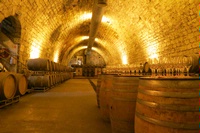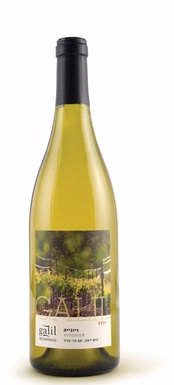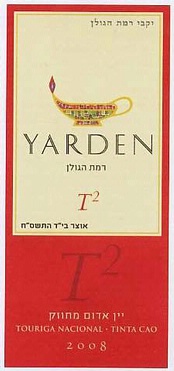|
|
 |

Speaking candidly, I love to travel. One of the best things about my long love affair with wine is that it has enabled me to weasel my way all over the world. I won’t detail the wonderful destinations or the sheer number of trips, and for good reasons: It is bad karma to gloat over good fortune, and sheer envy might prompt some reader to hack my computer or slash my tires. Anyway, I love to travel, and if somebody calls at the last minute to learn if I’m up for checking out the food and wine scene in Israel, there’s no suspense. I’m going. The only question is whether the wine will be passably good, so that I can enjoy the trip with a reasonably clean conscience.
So guess what? The wine was remarkably good.
Just to be clear, there are two ways in which to make a statement like that. There’s the condescending way, like when your crazy uncle serves his homemade wine at Thanksgiving and you find it remarkable that nobody got sick. But when I report that Israeli wine turned out to be remarkably good, I say this with unqualified admiration, and also humility: The wines were so surprisingly good that I felt guilty for not knowing them better already.
I still don’t know them very well, and now that I’m aware of how good they can be, I continue to feel guilty for not knowing more about them than I do. Since I can’t lay claim to much expertise, I won’t be issuing pronouncements in this column, but rather focusing on the particular characteristics of the best wines that I now know by direct experience.
First, though, just a bit of background: Wine has been made on the territory of present-day Israel for at least four thousand years, yet the fine wine industry as it exists today is arguably only thirty years old. True, Baron Edmond de Rothschild (Paris banker and owner of Bordeaux’s Château Lafite) made large and historically important investments starting in the late 19th century that laid the foundations for later achievements. However, an industry based on high quality, estate-bottled wines made from top-shelf international varieties really didn’t get its start until 1983. wine industry as it exists today is arguably only thirty years old. True, Baron Edmond de Rothschild (Paris banker and owner of Bordeaux’s Château Lafite) made large and historically important investments starting in the late 19th century that laid the foundations for later achievements. However, an industry based on high quality, estate-bottled wines made from top-shelf international varieties really didn’t get its start until 1983.
That was the date of the founding of Golan Heights Winery, established on territory captured by Israel from Syria during the Six Day War in 1967. Shortly thereafter, in 1985, Jonathan Tishbi became the first vineyard owner to build his own winery (as opposed to selling grapes to a co-op) and establish an “estate” on the model first made famous in France. Today, Israel is home to scores of boutique wineries that began popping up rapidly in the 1990s, but fully 80% of national production still flows from just five large wineries: Barkan, Binyamina, Carmel, Golan and Teperberg.
Generally speaking, the push for quality in Israel has meant a push upward in altitude in search of relatively cool growing conditions, so the Golan Heights, Galilee and the Judean Hills are especially important. However, grapes of considerable quality are grown in many parts of the country, including land reclaimed from desert in the Negev, in the south of Israel.
A few words should be said about the relationship between quality and the various processes required for a wine to be kosher. The subject has been addressed by many writers so I won’t belabor it here, partly because many Israeli wines aren’t kosher, but more importantly because there is no direct relationship between kosher status and quality. Kosher status  requires that the product be handled exclusively by Sabbath-observant Jews, which can be cumbersome and perhaps costly but has no bearing on quality. requires that the product be handled exclusively by Sabbath-observant Jews, which can be cumbersome and perhaps costly but has no bearing on quality.
Additional measures must be taken for a wine to be “kosher for Passover,” but these are also irrelevant to wine quality, so there’s no point in detailing them for my limited purposes here. A relatively rare process that does actually have bearing on quality is flash pasteurization, which is required for a wine to attain status as “Yayin Mevushal.” This is of importance to strictly orthodox customers, who don’t regard a wine as truly kosher if it is not only handled during production but also served by a Sabbath-observant Jew--unless it has been pasteurized prior to serving. However, since very few of the Israeli wines that one might buy for reason of quality are mevushal, the only good reason to mention it at all is to counter any prejudice that kosher wines or wines from Israel are somehow compromised by nature.
Red wines account for 70% of production, which makes sense both in terms of worldwide consumption trends and the local climate (since aromatic expressiveness is more important for excellence in whites than reds, and heat is more the enemy of aroma than flavor). Whites account for 20%, sparkling for 7% and rosé for 3%. It would be a mistake to regard these categories as after-thoughts, as I tasted very good examples of all three. Anyone who regards wine from Israel as a curiosity is likewise mistaken, and indeed the country’s current level of accomplishment is astonishing when the sheer youth of the industry is considered. To come so far so fast is, well, remarkable.
Featured wines are reviewed below in order of score within categories. Prices are approximate and availability is spotty, but every wine in the following listing is worth a search:
SPARKLING:
Golan Heights Winery Golan Heights Brut “Gamla” 2010 ($30): High class bubbly from…Israel? Unlikely as it may seem that a wine type usually requiring a cool or cold climate could be sourced from an essentially desert country, the relative cool of the Golan Heights can apparently turn implausibility into actuality. Crafted entirely from Chardonnay and Pinot Noir, this displays outstanding balance, showing full flavor in a dry style, with expressive fruit but still an overall profile of restraint. Tasting is believing. 90
WHITE:
Galil Mountain Viognier 2012 ($15): If asked to list a dozen varieties  that might do well in Israel’s relatively hot growing conditions, I would certainly not have noted Viognier, which easily turns corpulent and hot with alcohol in warm, sunny climates like California’s. Indeed, I probably wouldn’t have gotten to Viognier if asked to name two dozen likely suspects, but this wine made an immediate believer out of me. It shows excellent expressiveness in the form of billowing floral aromas and pure, punch peach fruit flavors. Rich but not formless or hot in the finish, this was perhaps the single biggest surprise from a recent week of tasting in Israel. The attractive price is also a pleasant surprise. 91 that might do well in Israel’s relatively hot growing conditions, I would certainly not have noted Viognier, which easily turns corpulent and hot with alcohol in warm, sunny climates like California’s. Indeed, I probably wouldn’t have gotten to Viognier if asked to name two dozen likely suspects, but this wine made an immediate believer out of me. It shows excellent expressiveness in the form of billowing floral aromas and pure, punch peach fruit flavors. Rich but not formless or hot in the finish, this was perhaps the single biggest surprise from a recent week of tasting in Israel. The attractive price is also a pleasant surprise. 91
Carmel Winery Upper Galilee Kayoumi Vineyard Riesling 2011 ($18): Riesling may seem like an unlikely vine variety for cultivation in arid Israel, but after reflecting on the success enjoyed in Australia with this variety and actually tasting the wine, I found this quite convincing. Essentially dry (only 5 grams of residual sugar per liter) with just a hint of sweetness that really suggests fruit rather than sugar, it shows a notable mineral or “petrol” aromatic note, and a pleasantly bitter edge to the finish (reminiscent of citrus rind) is a very nice foil to the faintly sweet mid-palate. This doesn’t pose an immediate threat to the best dry Rieslings of Germany’s Rheingau region, but there’s no question that this is a very successful wine, and given its point of origin, that is impressive indeed. 88
RED:
Carmel Winery “Limited Edition” 2008 ($77): This Bordeaux-style blend benefits greatly from a lovely impression of sweetness that presents itself on the attack and is sustained through the mid-palate and finish. The wine offers lots of dark berry fruit flavor from a platform that is really only medium-bodied, which makes the likeness to Bordeaux even more persuasive while also making for excellent versatility at the table, as this could work well with white as well as red meat dishes. With excellent proportionality of fruit, wood, acidity and tannin, this is very well made. 91
Ramot Family Winery Petit Verdot 2011 ($35): Fairly few vintners around the world make single-variety wines from Petit Verdot, which is usually utilized as a blending grape when color and tannic intensity are desired. The best solo bottlings tend to come from places like south-central Spain where intense sunlight seems to ripen the grapes into civility, and certainly Israel does not lack for warmth or sunlight…so this wine’s success isn’t entirely surprising. Dense, dark color makes it look true to form, and it also shows impressive depth and richness, but its key attribute is a soft sweetness that buffers the tannins and lends an element of charm to the finish. 91
Stern Winery Upper Galilee “Rotem” 2010 ($40): Grown in ferrous, Terra Rosa soils, this was blended from 52% Cabernet Sauvignon, 19% Merlot, 16% Cabernet Franc and 13% Petit Verdot. The fruit shows impressive intensity, with blackberry and black currant notes leading the way, but there are also savory nuances around the edges. An endearing impression of sweetness buffers the tannins in the finish, which is symmetrical and long. 91
Ortal Winery Golan Heights Syrah 2010 ($35): This was one of several complete and convincing renditions of Syrah tasted in Israel, and like the best of the others, it succeeded on the strength of ripe, rich fruit that showed enough structure and restraint to allow other meaty, savory nuances to present themselves as well. Full of primary fruit but neither chunky nor obvious, this was admirably nuanced and satisfying. 91
Golan Heights Winery Golan Heights “T2” 2009 ($40): You’ll get the  proprietary name once you learn that this was made from Touriga Nacional and Tinta Cão, two of the Portuguese varieties from the Douro Valley. Fruit recalling dried red cherries shows prominently, but the wine also displays savory qualities and a suggestion of cured meat and spices. Complex and enduringly interesting. 91 proprietary name once you learn that this was made from Touriga Nacional and Tinta Cão, two of the Portuguese varieties from the Douro Valley. Fruit recalling dried red cherries shows prominently, but the wine also displays savory qualities and a suggestion of cured meat and spices. Complex and enduringly interesting. 91
Lueria Upper Galilee “Grand Vital” 2008 ($40): This producer also turns out a Sangiovese-Barbera blend and a credible Gewurztraminer, but this nuanced, serious blend of 70% Cabernet Sauvignon, 20% Syrah and 10% Merlot is quite clearly the pick of the litter. The aromas show fine complexity and the flavors are meaty and savory as well as fruity, with nothing chunky or overt, which is an accomplishment of note from the hot 2008 growing season. 91
Lotem Winery “Vivace” 2011 ($38): Made entirely from Cabernet Sauvignon, this is a more structured and serious wine than its stablemate “Trio” blend. Showing very pleasant and varietally-appropriate herbal aromas that one might expect from a cooler climate than Israel’s, this also shows fine freshness and lots of linear energy. Dark berry fruit is accented with subtle notes of cocoa powder and subtle spices. 91
Carmel Winery Carignan Old Vine 2008 ($26): Given how well Carignan (a.k.a. Carignano and Cariñena) performs in relatively hot climates elsewhere around the Mediterranean, it doesn’t come as much of a surprise that it can succeed in Israel. The aromas show a very engaging and pleasant rusticity as well as a whiff of high-class oak, and the fruit shows a ripe character that pulls up just short of over-ripeness. Tasted blind, this could easily be confused for a top Cariñena-based wine from Catalonia. 90
Carmel Winery “Mediterranean” 2008 ($58): This complex blend resulted from a non-elective experiment conducted in 2006, when warfare to the north in Lebanon prevented the Carmel staff from getting into their vineyards to harvest at the point when they would normally have picked. They observed that some varieties performed much better than others when left to hang in the heat, and brought those together to make this continuing blend of Carignane, Petite Sirah, Shiraz, Petit Verdot, Malbec and Viognier. The fruit is sourced from sites across northern Israel, and the initial flavors show an appealingly ripe impression of sweetness, followed by a serious and dry mid-palate and a finish with a classy, grippy character marked by fine-grained tannins. At once rustic and fine, this is very interesting and quite impressive. 90
Odem Mountain Galilee Shiraz “Volcanic” 2010 ($26): Fruity and even juicy in character, this shows relatively little oak but still plenty of punch. However, it is no mere fruit bomb, as there’s plenty of acidity to freshen the flavors and structure the finish. The flavors are deep and persistent, and though this seems pretty international in style, it is very satisfying. 90
Galil Mountain “Yiron” 2009 ($25): This blend of 60% Cabernet Sauvignon, 35% Merlot and 5% Petit Verdot was quite warm when served to me in the scorching sun of an afternoon wine festival in Galilee, and though I can think of few worse conditions for tasting it, it managed to impress against all odds. Rounded in texture and impressively deep in flavor, it showed ripe flavors of dark cherries and berries, but the ripeness wasn’t excessive and the overall impression was one of balance rather than bluster. Other big red wines that I experienced under these conditions tasted like soup, but this one was still able to sing, which was pretty damned impressive. 90
Or Haganuz Galilee Zuta Vineyard Plot Cabernet Sauvignon 2011 ($33): An impressive wine, this shows dark pigmentation and backs it up with moderately intense fruit recalling blackberries and black currants. Adequate acidity and plenty of fine-grained tannins provide structure and grip in the finish, and there’s every reason to believe that this will get even better over the next five years. 90
Na’aman Upper Galilee “Deep Purple” 2010 ($40): This was the most successful wine in a lineup of releases named with rock band puns like King Crimson and Pink Floyd (yes, a rosé). One wonders why this hasn’t resulted in endless litigation since Pink Floyd, for example, could have grounds based on copyright infringement or, alternatively, defamation (the rosé was…um…not very good). Nevertheless, this blend of Cabernet Sauvignon, Merlot, Cabernet Franc and Petit Verdot is a winner, showing dark-toned fruit, good depth, classic structure, surprising minerality and impressive overall complexity. 90
Ramot Family Winery Barbera 2011 ($28): Barbera is a variety that is naturally high in acidity but low in tannin, which makes it a strong candidate for success in Israel’s arid conditions. And sure enough, this wine is a winner, featuring complex bouquet of red berries, cured meat, saddle leather and spices. Although light in color and notably acidic in profile, it punches above its weight, delivering lots of flavor from a relatively light base and making it a promising partner for a very wide range of foods. 90
Stern Winery Upper Galilee Cabernet Franc 2011 ($35): Since growing conditions everywhere in Israel are sufficiently warm and sunny to fully ripen any grape variety grown anywhere, it was rather surprising to find several excellent renditions of Cabernet Franc, which is utilized precisely for early ripening almost everywhere it is grown. Be that as it may, this wine (which was grown in predominantly limestone soils) shows a highly expressive, varietally-correct bouquet based on complex herbal scents. There’s nothing weedy or vegetal about the aromas, however, and the grapes were clearly ripened fully, as there’s a lovely impression of sweetness to the fruit that persists to the very end of the balanced, persistent finish. 90
Carmel Winery Upper Galilee Cabernet Franc “Appellation Series” 2008 ($20): The 2008 growing season in the Upper Galilee was hot, and might consequently have cooked the varietal character out of a wine like this, but it shows a very pleasant herbal character that really rings true to Cabernet Franc. Admirably dry in style, with mature fruit and a structured, grippy finish, this is quite well done. 89
Ram Galilee Shiraz 2009 ($30): Syrah and Shiraz remain rather tough to sell around the world, perhaps because it isn’t easy for consumers to predict what style they’ll find after pulling the cork on any given wine. Nevertheless, northern Israel seems to produce a pretty consistent wine from the variety, and this rendition stands as a fine example: Meaty and generously flavored but not chunky or obvious, with dark berry fruit that outshines the structural elements of acidity, tannin and wood. All three of these are evident but only on the margins, giving the wine a character that is--at once--straightforward but also layered. Very promising for moderately robust dishes based on duck or veal. 89
Lotem Winery “Trio” 2011 ($30): An organic blend of Cabernet Sauvignon, Cabernet Franc and Merlot, this impresses with deeply pigmented color, expressive aromas of sweet fruit, and a broad, plush texture. Acidity is low but evident and adequate, and while I wouldn’t bet on this to improve much from ageing, it is a generous and winning wine for current consumption. 89
Recanati Upper Galilee Manara Vineyard Syrah-Viognier Reserve 2009 ($25): This performs very well in terms of flavor and is even more impressive in aromatic terms, showing lovely floral and leathery notes that are very interesting together. The berry flavored fruit shows more red than black fruit character but does include suggestions of both, and though there’s a bit of astringency at the very end of the finish, this certainly merited the 90 points noted here, and as my note at the time of tasting indicates, it really smells more like 93. 89
|
 |
|